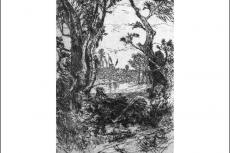A final design for a stormwater abatement project at the Route 27 rest stop adjacent to Georgica Pond in Wainscott was presented to the East Hampton Town Board on Tuesday.
The pond has long been ecologically compromised, and the rest stop, neighboring the pond’s Talmage Creek, has been identified as a source of significant runoff. Efforts to mitigate excess nitrogen by replacing aging septic systems with the newest models, together with an aquatic weed harvester that removes macroalgae, have proven beneficial to the pond, which experienced multiple blooms of toxic cyanobacteria, or blue-green algae, over the last decade.
Sara Davison, executive director of the Friends of Georgica Pond Foundation, along with Matt Swain, a senior stewardship manager with the Peconic Land Trust, addressed the town board before engineers presented the plan. The land trust acquired the parcel adjacent to the creek a few years ago, and demolished a restaurant building there before returning the land to its natural state.
“Short of moving that rest stop, this is the best alternative we have to correct a serious problem,” Ms. Davison told the board. With increasing instances of severe weather, she said, “this project is needed more than ever.”
“Dangerously high” bacteria levels have been measured at the site, she added, particularly after heavy rains. A 2016-2017 study showed that the highest levels of bacteria in Talmage Creek originated from dog and small mammal waste, as well as from birds and humans. “Pet waste is a known contaminant in stormwater,” Ms. Davison said, “and it can travel a great distance in the stormwater and enter the pond.”
Mr. Swain said that he himself cleans the site weekly, removing an average of two garbage bags’ worth of debris from the pond. “Those are just things we can see,” he told the board. “There’s so much bacteria, salt runoff, oil, gasoline coming into that pond.” The stormwater abatement project, he said, is “totally necessary.”
Along with the rest area, the project includes a portion of the Peconic Land Trust property, and, to the north of Route 27, Old Montauk Highway. Stakeholders also include the State Department of Transportation, the town trustees, and East Hampton Village.
The project is intended to reduce and capture runoff through installation of a concrete curb running from the land trust property to the far end of the rest area. This, said Tom Schaefer of D&B Engineering, will prevent runoff from entering the pond directly. Along the parking area, he said, “We are proposing to install porous asphalt parking,” allowing runoff to permeate through it.
The plan also calls for a catch basin on either end of the parking area. “Any runoff that isn’t infiltrated into the porous asphalt will go into these catch basins,” Mr. Schaefer explained, capturing sediment before it enters the stormwater piping that will connect the structures. The piping — perforated, to allow runoff to infiltrate — will connect with a below-grade stormwater treatment unit that will treat runoff that isn’t infiltrated into the soil.
A permeable walkway will also be installed, allowing access to the pond, and a split-rail fence will be built behind the concrete curb. An overflow swale will treat runoff from storms that exceed the project’s ability to address it. Along the shoulder of Old Montauk Highway, a bioswale is to be installed, protected by another split-rail fence.
Native plant species will be used, Gabriella Verderber of Araiys Design told the board. Their stabilized root systems, she noted, will exist beyond the project’s five-year maintenance plan. “Any stormwater that does happen to make it into this planting area, their roots will help to absorb the quantity of the water and also purify it before it percolates back down into the ground or gets into the pond.”
Species are to include swamp red maple, sweet pepperbush, northern bayberry, highbush blueberry, and several grasses and perennials. “The focus here was for stabilization of the bank that’s there, as well as the drainage area,” Ms. Verderber said.
The plantings are designed to be self-sustaining around the third year, Mr. Schaefer said, and will be well established by the end of the five-year maintenance plan. Beyond that, biannual maintenance, such as removal of garbage and debris and any invasive species from the landscaped area, is anticipated. The stormwater piping and structures are also expected to require biannual cleaning.
The engineering phase of the project was funded through the Suffolk County Water Quality Protection and Restoration Program and the community preservation fund. Mr. Schaefer forecast a three-to-four-month period to prepare the plans for permits from the State Department of Environmental Conservation. The project is expected to be put out to bid in the summer and awarded in the fall.



